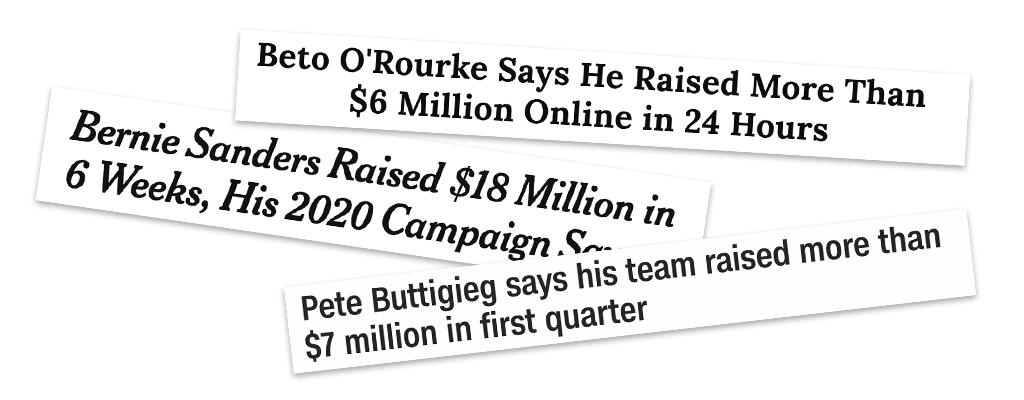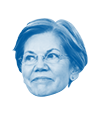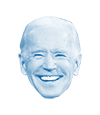Get more FiveThirtyEight
- Terms of Use
- Privacy Policy
- Your California Privacy Rights
- Children's Online Privacy Policy
- Interest-Based Ads
© 2018 ABC News Internet Ventures. All rights reserved.
When a presidential candidate raises a lot of money, they’re probably going to tell you about it, which leads to a lot of headlines like this:

Those headlines aren’t wrong, but they also don’t tell you that much on their own. That’s because each candidate who’s bragging about his or her fundraising total is doing it in a vacuum. It’s tough to know whether to care about, say, Bernie Sanders’s haul without knowing what the other candidates brought in.
Luckily, all candidates must file detailed reports of their fundraising and spending at least once a quarter. This information, which is made public by the Federal Election Commission, allows for a better kind of analysis: one that compares each candidate to all the others. We’re going to help you do that.
This primary season, FiveThirtyEight and the Center for Public Integrity, a nonprofit investigative news organization, are teaming up to track those filings and update this page with the latest numbers each quarter. Fundraising is obviously hugely important to a political campaign, but fundraising numbers alone can’t always tell you whether a campaign is going strong or hitting the skids. (For example, women and people of color generally have a harder time raising money than white men do, so a strong quarter for Kamala Harris might still bring in a lower total than a similarly strong quarter for Sanders.) Instead, think of fundraising as one more indicator of campaign health, alongside things like endorsements, polls and media coverage. Together, all these metrics give us a sense of who is attracting attention heading into the primaries and caucuses.
Here’s how the 2020 money race is shaping up. Totals here include all the money a candidate raised for the presidential race this quarter, regardless of whether it’s earmarked for the primary or the general election.
Tom Steyer led the Democrats this quarter, raising $49.6 million total, of which 4.1 percent was raised from individual donors and 95.9 percent came from his own wallet. That total is $21.6 million more than Bernie Sanders, who came in second with $28.0 million, and $8.7 million more than President Trump, who raised $41.0 million in the third quarter. But wait, you might grumble, this is exactly the sort of boring financial coverage that gives people an incomplete picture of the race!
You’d have a point. In general, these numbers make more sense when they’re judged against candidates’ expectations. We’ve written before about the relationship between poll numbers and name recognition — namely, politicians tend to have higher net favorability ratings when more voters know who they are — and it stands to reason that higher name recognition could translate to more money as well. After all, people don’t donate to candidates they’ve never heard of.
Here’s how Democratic candidates’ fundraising this quarter compares to their name recognition.
Not well known, raised a lot
Well known, raised a lot
Not well known, raised a little
Well known, raised a little
Joe Biden, who leads in name recognition at 90.4 percent, was the fourth-place fundraiser in terms of money raised from individual donors in the third quarter. (This total excludes money raised from other sources, like transfers from political committees and money the candidate gave to their own campaign.)
Candidates’ fundraising totals for each quarter generally include not just money raised from individual donors, but also money from PACs, money left over from previous campaigns and money from the candidate’s own pocket.
Here’s where each Democratic candidate’s money came from so far this year.


















But how fast candidates are bringing money in isn’t the only relevant measure here; it also helps to know how fast money is flowing out. Burn rate — total spent divided by total raised — measures how quickly candidates are spending their money, and cash on hand shows how much of a buffer a campaign has socked away, which could help it weather a rough patch if costs rise or donations plummet. Presidential campaigns raise and spend money faster than a Silicon Valley startup, so having a safety net is essential to keeping operations up in the lean times.
| name | total raised | total spent | cash on hand | burn rate | |
|---|---|---|---|---|---|
| John Delaney | $21.1M | $20.8M | $0.5M | 98.7% | |
| Tom Steyer | 49.6 | 47.0 | 2.6 | 94.7 | |
| Julián Castro | 7.4 | 6.9 | 0.7 | 93.7 | |
| Marianne Williamson | 6.1 | 5.4 | 0.7 | 88.2 | |
| Tim Ryan | 1.3 | 1.2 | 0.2 | 88.0 | |
| Beto O’Rourke | 17.5 | 14.2 | 3.3 | 81.4 | |
| Amy Klobuchar | 17.5 | 13.8 | 3.7 | 79.0 | |
| Cory Booker | 18.5 | 14.3 | 4.2 | 77.2 | |
| Joe Biden | 37.8 | 28.8 | 9.0 | 76.2 | |
| Tulsi Gabbard | 8.6 | 6.5 | 2.1 | 75.1 | |
| Kamala Harris | 36.9 | 26.4 | 10.5 | 71.4 | |
| Steve Bullock | 4.4 | 3.0 | 1.4 | 68.8 | |
| Michael Bennet | 5.6 | 3.8 | 1.9 | 66.8 | |
| Elizabeth Warren | 60.3 | 34.6 | 25.7 | 57.4 | |
| Andrew Yang | 14.5 | 8.2 | 6.4 | 56.5 | |
| Pete Buttigieg | 51.5 | 28.2 | 23.4 | 54.6 | |
| Bernie Sanders | 74.4 | 40.6 | 33.7 | 54.6 | |
| Joe Sestak | 0.4 | 0.2 | 0.2 | 45.3 |
There aren’t any objectively good or bad numbers here. But according to an analysis by Echelon Insights, the average presidential campaign had a 69 percent burn rate through Sept. 30 of the year before the election.
The Democratic Party is putting a lot of weight on grassroots fundraising this election cycle. That’s in part because of ActBlue, an online Democratic fundraising tool that has raised over $3 billion for the party by helping to fuel a surge of small-dollar donations.1Thanks in part to ActBlue, Democrats running for Congress raised over three times as much from small donors between January 2017 and Sept. 2018 as they did over the same 21-month span in the 2014 election cycle. When the Democratic National Committee made fundraising a criterion in determining which candidates qualify for the party’s first debates, it specified a minimum number of donors per candidate but not a minimum dollar number, prioritizing candidates who could demonstrate broad national support even if their fundraising totals were relatively low.2Candidates who get donations from at least 65,000 people (including a minimum of 200 donors from each of at least 20 states) will be eligible to take the stage in the first two debates. Candidates must collect donations from at least 130,000 people, plus clear a polling threshold, to participate in the third debate.[a]
No one is doing better with small donors than Bernie Sanders, who raised $43.0 million, or 57.8 percent of his total, from donors who gave $200 or less.3The FEC rules allow campaigns to report less information about donors who give a total of $200 or less.
Overall this year, 40.1 percent of Democrats’ funding came from small donors. For Trump, 15.2 percent of his total haul came from people who gave less than $200. Here’s the breakdown for all the Democrats as a group and for Trump on his own for the first, second and third quarters.4Trump has been fundraising for his re-election campaign since he was inaugurated in 2017, so his totals for this year represent a fraction of his total fundraising.
Where is all this money coming from? For now, we can only tell you where candidates’ big donors live. The FEC requires candidates to provide the names and addresses of donors who give more than $200. When we divide the total value of big-dollar donations from each state by an estimate of how many Democratic voters live there,5We’re dividing the total value of donations by the number of registered voters in the state according to a 2018 Census Bureau report, and then dividing that number by the percentage of the state who said they were Democrats or Democratic-leaning independents in a 2017 Gallup poll. Washington, D.C., gave the most on a dollars-per-Democrat basis.
| Dollars per Dem. | Total |
|---|---|
| $ |
*To get the dollars-per-Democrat figure, the total dollar value of donations from the state was divided by the number of registered voters in the state, and that number was divided by the percentage of the state that identified as a Democrat or Democratic-leaning independent in a 2017 Gallup poll.
A look at the early-primary states can show us which candidates are resonating with key voters there. In Iowa, Bernie Sanders received the most big-dollar donations so far this year. Bernie Sandersalso led in New Hampshire.
So, how much does all this matter? FiveThirtyEight’s own Maggie Koerth-Baker wrote in 2018 that fundraising is an inefficient metric for assessing general elections, but it’s pretty useful for gauging the primaries. Winning the nomination requires building name recognition and demonstrating viability, particularly in a field with over a dozen candidates. A great fundraising quarter signals to voters — and the DNC — that a candidate is on track to do just that.
CORRECTION (Feb. 1, 2020, 7:30 p.m.): Due to a coding error affecting candidates who began fundraising before 2019, a previous version of this story gave incorrect cash-on-hand numbers for John Delaney and Julián Castro
Comments